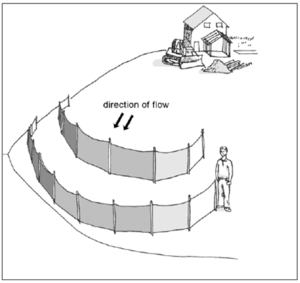
Sediment control practices - Perimeter controls for disturbed areas
This page is under development. We anticipate populating it in autumn, 2016.
Perimeter Controls for Disturbed Areas
Definition
Perimeter controls for disturbed areas are temporary sediment barriers that intercept and remove soil and debris from sheet flow runoff on construction sites. Removal mechanisms include ponding the runoff to allow for settling, and physically filtering sediment as it passes through a sediment barrier (e.g., silt fence, rock/soil berm, gravel bags, fiber log, etc.). Some designs (e.g., berms, ditches) use perimeter controls to collect and convey sheet flow to larger treatment areas, such as sediment traps, where sediment removal can occur through multiple processes.
Purpose and Function
Perimeter controls intercept sheet flow from slopes and remove sediment and other contaminants through ponding, settling, and physical filtration, effectively preventing contaminants from leaving the site and entering surface waters. Concentrated flows within the site typically require treatment via source controls, sediment traps, settling ponds, or other methods prior to reaching the site perimeter. Ditch check dams are also used for small concentrated flows.
Although silt fences are one of the most commonly used methods of perimeter control, other perimeter control BMPs are available that can be equally or more effective depending on site conditions. Typical perimeter control methods include:
- Silt fence (super duty, machine sliced, hand installed, preassembled)
- Ditch checks (fiber rolls/biorolls, filter/rock/compost log, etc.)
- Sediment traps or berms (rock, soil, compost, etc.)
- Perimeter control ditches
- Other (sand bags, rock logs, snow berm, etc.)
In most applications, treatment occurs at or along the perimeter control device, e.g., silt fence, rock berm, and fiber log. Other applications may involve the use of perimeter control berms or ditches to direct sheet flows to a treatment area, such as a sediment trap, sediment basin, or other BMP. Perimeter controls are generally recognized as the last line of defense in a system of erosion prevention and sediment control, and are usually placed near the downgradient borders of disturbed areas and soil stockpiles. They are also used to separate work zones from adjacent waterbodies.
